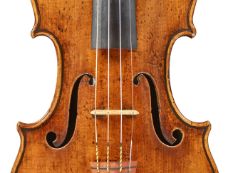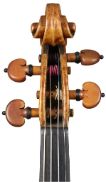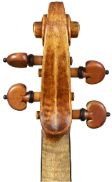Violin, Antonio Stradivari, Cremona, around 1698, “ex Rouse-Boughton”
Druckzettel: „Antonius Stradiuarius Cremonensis / Faciebat Anno 1703“ (703 handschriftlich)Although the printed label states that the instrument was built in 1703, the violin is now assumed to have been built around 1698 on account of its stylistic features. This information is based on a certificate made out by W. E. Hill & Sons in 1913, according to which the label is a facsimile. In the early 1690s, Stradivari developed a body model that was several millimeters longer than the one he had used previously. An example of this so-called long pattern model is the “ex Benecke” Stradivari from 1694. Only a few years later, Stradivari returned to shorter body models. One of the inner molds Stradivari used is lettered “S.” It is shorter than the long pattern model, but has somewhat wider lower bouts. The rib garland of the “ex Rouse-Boughton” violin matches the contours of this inner mold very well. Quite possibly, the instrument was built on this form. The two-piece belly has symmetrical halves of extremely fine-grained wood. The average tree ring width is half a millimeter. The youngest tree ring is dated 1684. The one-piece, quarter-cut back exhibits marvelous flames that are narrow and regular and that descend slightly toward the bass side. The wood of the ribs matches that of the back. The instrument has medium-high arching. Its f-holes are positioned very close to one another and are elegantly shaped. The regular, symmetrically executed scroll is typical of Stradivari’s work. An orange-red varnish coats a golden-yellow, highly transparent ground.
The instrument’s owners are documented completely from the early 19th century. After Sir Charles William Rouse Boughton (1747–1821) had purchased the violin in 1810, it remained in his family’s possession for nearly a century. Sir Charles was employed by the East India Company and lived in Asia from 1765. After inheriting an estate in Worcestershire, he returned to England and was elected as a member of the British House of Commons in 1780. No information is available on his music ambitions. In 1907, the violin came into the possession of English collector Robert Augustus Bower through W. E. Hill & Sons. Bower’s collection included at least 27 instruments built by Stradivari in the course of his life. In 1912, Bower sold the violin to August Herrmann, a dealer in Berlin. After World War I, the Stradivari came into the possession of Frank Gittelson via violinist Willi Seibert. In 1914, Gittelson, who had studied with Flesch and Auer in Europe, made a successful debut in the USA, which became his new home. He sold the Stradivari to the German violinmaker Emil Herrmann, who had lived in New York since 1823. The instrument was then purchased by David S. Carter and finally by violinist Olga Monks-Perzoff of Boston. Further sales to private collectors were handled by Rembert Wurlitzer after World War II.












